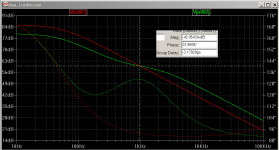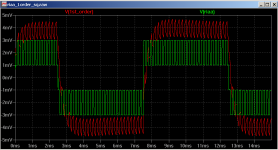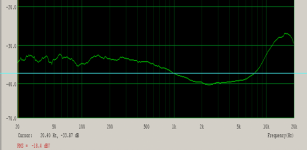Features and Technical Data:
Frequency response, DC to 70 Khz
No "RIAA" filter circuitry is required or used in our preamp - just one ULTRA clean gain stage (this is because the Stgrain Gauge is a "displacement" device, not a "velocity" sensitive device like magnetic cartridges).
Compatible with standard "4 wire" tone arm wiring
This is what is mentioned on their website, and they say that their preamp is just "one ULTRA clean gain stage" which I think is just a load of BS, cause you have to correct for the equalization recorded into the grooves of the record.
The cheapest system is $5000+. But the replaceable styli are not expensive, starting at $150.00.
I'm wondering, does anyone know what is in the phono preamp box. With the correct kind of test LP, one could design and build a phono preamp for the strain gauge stylus.
So, I'm thinking about it. But, also wondering if this system is really better, and if I would be just wasting my time.
Frequency response, DC to 70 Khz
No "RIAA" filter circuitry is required or used in our preamp - just one ULTRA clean gain stage (this is because the Stgrain Gauge is a "displacement" device, not a "velocity" sensitive device like magnetic cartridges).
Compatible with standard "4 wire" tone arm wiring
This is what is mentioned on their website, and they say that their preamp is just "one ULTRA clean gain stage" which I think is just a load of BS, cause you have to correct for the equalization recorded into the grooves of the record.
The cheapest system is $5000+. But the replaceable styli are not expensive, starting at $150.00.
I'm wondering, does anyone know what is in the phono preamp box. With the correct kind of test LP, one could design and build a phono preamp for the strain gauge stylus.
So, I'm thinking about it. But, also wondering if this system is really better, and if I would be just wasting my time.
Sorry to burst your BS bubble hopes, but the strain gauge principal (constant velocity or constant amplitude, I forget which) pretty much follows the RIAA playback curve so all that is needed is a power supply to power the gauge followed by a linear amplifier. I have heard the cartridge many times and it is truly remarkable. A friend built up his own "front end amplification" for it also.
Stereophile has reviewed it a few times in the past year.
Peter Liebermann is to be congratulated.
Charles
Stereophile has reviewed it a few times in the past year.
Peter Liebermann is to be congratulated.
Charles
Last edited:
Sorry to burst your BS bubble hopes, but the strain gauge principal (constant velocity or constant amplitude, I forget which) pretty much follows the RIAA playback curve...
...except for some major deviations in the midrange. You need EQ, just a different one than for a velocity-sensitive transducer.
simple Bode asymptote aproximations: ~ 1:4 zero-pole "flat spot" is going to give ~ 12 dB difference from the expected pure 1st order slope of a uncorrected strain gage cart response
could be viewed as 12 dB mid/high cut or +/- 6 dB at low/high vs 1 kHz matched level
but in any case "celarly audible" by just about anyone in ABX comparison with a accurate RIAA played on the same system - pink noise anyone?
it could be excused on not doing level matched comparisons, by just walking into a demo room with unknown speakers/room frequency response - still I would be suprized that anyone with truely trained ears - even many "lesser trained" ears than recording/mastering engineers, techs wouldn't pick up on that much error even if they weren't sure where to place the blame
red single pole response - I assume even though strain gages give DC response any audio system won't like it so I kept the 50 Hz corner
green RIAA, the curves level matched at 1 KHz
looks like 38 degrees, 3.2 uS phase, time errors - where our hearing is pretty sensitive too
I pre-emphasized 2mV, 100 Hz + 1 mV, 5 KHz square waves and put them thru the 1st order 50 Hz LP and full RIAA eq
with 1 KHz matched EQ levels for minimum FR error you can see red single pole "uncorrected strain gage cart" response is wrong at both low and high frequencies
but what's +/- 6 dB error as long as there's a good audophile story attached?
Attachments
Last edited:
Hello stellavox
I am writing this with the utmost respect:
His name is Peter Ledermann.
Sincerely,
Ralf
Peter Liebermann is to be congratulated. Charles
I am writing this with the utmost respect:
His name is Peter Ledermann.
Sincerely,
Ralf
JCX, thanks for the information.
So, you're saying the strain gauge is just a first order slope. It looks like that first order slope closely matches the first part of the RIAA curve. I mean if you had the low frequency amplitude set the same, you'd have the first pole.
Did you measure a strain gauge cart? It wasn't clear to me from you post.
Anyway, if the response is like that, all one has to do is get rid of the first pole on a standard phono preamp, and the rest is taken care of.
I'd be interested in doing this. I've got my Pearl phono preamp boards stuffed and working, so perhaps I could mod the filter and get rid of the first pole in a way that doesn't affect the rest of the filter response.
I mean if that really is the response of the strain gauge.
Does anyone know of a good test LP, with test frequencies I could use to get the response of the strain gauge cart?
John
So, you're saying the strain gauge is just a first order slope. It looks like that first order slope closely matches the first part of the RIAA curve. I mean if you had the low frequency amplitude set the same, you'd have the first pole.
Did you measure a strain gauge cart? It wasn't clear to me from you post.
Anyway, if the response is like that, all one has to do is get rid of the first pole on a standard phono preamp, and the rest is taken care of.
I'd be interested in doing this. I've got my Pearl phono preamp boards stuffed and working, so perhaps I could mod the filter and get rid of the first pole in a way that doesn't affect the rest of the filter response.
I mean if that really is the response of the strain gauge.
Does anyone know of a good test LP, with test frequencies I could use to get the response of the strain gauge cart?
John
In my MPP thread you find enough information to build a strain gauge phono amp based on the Panasonic models. I have also published FRD curves there. Without any correction you get a presence dip and a rise in the upper treble so without any EQ is plays but does not sound optimum. I have shown a way to build an equalizer.
The Ledermann cartridge may behave different but i can not tell. Scanning the web i did not find any reliable information about what he does exactly but i would be surprised if zero EQ is the ticket.
The Ledermann cartridge may behave different but i can not tell. Scanning the web i did not find any reliable information about what he does exactly but i would be surprised if zero EQ is the ticket.
http://www.diyaudio.com/forums/analogue-source/154210-mpp-315.html#post2789133
I found this with a search, but nothing else.
I found this with a search, but nothing else.
The Audio Radio Handbook contains a description of the equalization required by a crystal cartridge. The crystal cartridge is also displacement device so the equalization might be the same for a strain gauge cartridge.
National Semiconductor Audio/Radio Handbook - Circuit Cellar, Inc.
Ray
National Semiconductor Audio/Radio Handbook - Circuit Cellar, Inc.
Ray
Cobra2, thanks! Interesting.
It looks fairly easy to correct the frequency deviation on the panasonic strain gauge carts. The Sound Smith cart should be easy too given others comments.
Anyway, I hope do this soon but got a speaker project to finish, and don't have have the funds right now.
It looks fairly easy to correct the frequency deviation on the panasonic strain gauge carts. The Sound Smith cart should be easy too given others comments.
Anyway, I hope do this soon but got a speaker project to finish, and don't have have the funds right now.
In my thread you find the response of the Panasonic.
Hi Joachim and all,
You may want to read all the pages on the Vinylengine thread called "preamp for strain gauge" or something like that.
I've done two circuits, one is proven, the other (the new one) you should ignore for now.
Basically to do a Panasonic SG cartridge preamp is extremely simple: The catridge measures 800 ohms. Use a battery to get +9V, connect this in series with a 2.2K resistor and the strain gauge. Total resistance = 3Kohm. Then 9V/3Kohm = 3mA which is within the 2-6mA desired current for powering up the strain gauge.
The output, obviously, will have a DC bias, you will have to use a capacitor as a High Pass filter to remove it. Then add about 32-38dB of gain to bring the out to AUX/LINE levels.
Now, equalization is another thing... The cartrige doesn't have a flat response. It has a slight peak around 100-300Hz of about +2dB, and then a pronounced valley of about -3dB from 2KHz-6KHz (i'm recalling this from my head, don't take these figures as exact). But the real thing is that response from 15KHz-20KHz goes up to the sky (+6dB).
I find that the most important thing is to correct the highs using a standard low pass filter with cutoff at 10 to 13KHz (to suit your taste). The 2KHz-6KHz valley is better not to correct since IMHO it gives a 'pleasing' sound.
I do have an EQ circuit on the Vinylengine thread that in theory would give a flat response, but i haven't tested it due to lack of time. However, i think that the most important thing is to filter those extreme highs.
Greetings,
Flavio81
I forgot to add, you need to invert one of the two outputs. I do this by connecting one strain gauge to +9V and the other one to -9V, so one is inverted (relative to the other).
Another way is to use an inverting op-amp.
Another way is to swap the polarity of one of your speakers.
Another way is to use an inverting op-amp.
Another way is to swap the polarity of one of your speakers.
- Status
- This old topic is closed. If you want to reopen this topic, contact a moderator using the "Report Post" button.
- Home
- Source & Line
- Analogue Source
- Sound Smith Strain Gauge Phono Preamp


